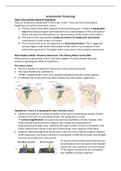Summary
Summary Sensorimotor Processing - Research Master - Maastricht University
- Course
- Institution
This summary includes a concise but still very detailed summary of all the mandatory literature of the course. It is written in full sentences to make everything understandable for you. Each paper is divided into aim of the paper, the task, the results and the overall conclusion and interpretation....
[Show more]



